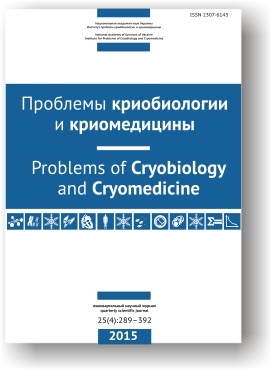PEG-6000 Induced Precipitation of Proteins from Cold-Acclimated Tenebrio molitor larvae
DOI:
https://doi.org/10.15407/cryo25.04.350Ключевые слова:
Ñ…Ð¾Ð»Ð¾Ð´Ð¾Ð²Ð°Ñ Ð°ÐºÐºÐ»Ð¸Ð¼Ð°Ñ†Ð¸Ñ, белки, полиÑтиленгликоль, преципитациÑ, ÑлектрофорезАннотация
Ð’ Ñравнительном аÑпекте иÑÑледованы Ñпектры преципитированных ПÐГ-6000 белков неакклимированных и акклимированных личинок Tenebrio molitor. Показано, что качеÑтвенный ÑоÑтав криопреципитированных белков акклимированных и неакклимированных личинок T. molitor имеет отличиÑ. Ð’ чаÑтноÑти, в белковых Ñпектрах фильтратов из акклимированных личинок поÑвлÑлиÑÑŒ белки Ñ Ð¼. м. 11 кДа, которые отÑутÑтвуют у неакклимированных наÑекомых. При преципитации белков из гомогенатов холодоакклимированных и неакклимированных личинок наблюдалаÑÑŒ Ð·Ð½Ð°Ñ‡Ð¸Ð¼Ð°Ñ Ñ€Ð°Ð·Ð½Ð¸Ñ†Ð° в количеÑтве преципитата при концентрациÑÑ… полиÑÑ‚Ð¸Ð»ÐµÐ½Ð³Ð»Ð¸ÐºÐ¾Ð»Ñ 12% и более. Белки из фильтратов акклимированных ли-чинок в приÑутÑтвии 6%-го раÑтвора ПÐГ-6000 оÑаждалиÑÑŒ на 44 и 56% больше, чем белки из неакклимированных оÑобей при 22 и 4°С ÑоответÑтвенно. Увеличение концентрации ПÐГ-6000 от 4 до 6% приводило к поÑвлению в преципитатах из акклимованных личинок белков в диапазоне м. м. 30–42,5 кДа, которые отÑутÑтвуют в неакклимированных наÑекомых.
Библиографические ссылки
Aghajari N., Feller G., Gerday C. et al. Structures of the psychrophilic Alteromonas haloplanctis a-amylase give insights into cold adaptation at a molecular level. Structure 1998; 6 (12): 1503–1516. CrossRef
Alvarez M., Zeelen J.P., Mainfroid V. et al. Triose-phosphate isomerase (TIM) of the psychrophilic bacterium Vibrio marinus. Kinetic and structural properties. J Biol Chem 1998; 273 (4): 2199–2206. CrossRef PubMed
Arnоrsdоttir J., Smaradоttir R.B., Magnusson O. et al. Characterization of a cloned subtilisin-like serine proteinase from a psychrotrophic Vibrio species. Eur J Biochem 2002; 269 (22): 5536–5546. CrossRef
Ciardiello M.A., Camardella L., Carratore V. et al. L-glutamate dehydrogenase from the antarctic fish Chaenocephalus aceratus. Primary structure, function and thermodynamic characterisation: relationship with cold adaptation. Biochim Biophys Acta 2000; 1543 (1): 11–23. CrossRef
Bhat R., Timasheff S.N. Steric exclusion is the principal source of the preferential hydration of proteins in the presence of polyethylene glycols. Protein Science 1992; 1: 1133–1143. CrossRef PubMed
Fields P.A., Houseman D.E. Decreases in аctivation еnergy and substrate affinity in cold-adapted A4-lactate dehydrogenase: evidence from the Antarctic notothenioid fish Chaeno-cephalus aceratus. Mol Biol Evol 2004; 21 (12): 2246–2255. CrossRef PubMed
Gulevsky A.K., Ryazantsev V.V., Grischenkova Ye.A., Relina L.I. Changes in protein composition of mealworms (Tenebrio molitor) during cold acclimation. Problems of Cryobiology 1995; (4): 29–32.
Korolevskaya L.B., Shmagel K.V. Spectroturbidimetric deter-mination of serum aggregates formed in polyethylene glycol. Immunologiya 2010; 31 (2): 108–111.
Liou Y.C., Daley M.E., Graham L.A. et al. Folding and structural characterization of highly disulfide-bonded beetle antifreeze protein produced in bacteria. Protein Expr Purif 2000; 19 (1): 148–157. CrossRef PubMed
Marshall C.B., Daley M.E., Graham L.A. et al. Identification of the ice-binding face of antifreeze protein from Tenebrio molitor. FEBS Lett 2002; 529 (2–3): 261–267. CrossRef
Osterman L.A. Methods of investigating proteins and nucleic acids: Electrophoresis and ultracentrifugation. Moscow, Nauka; 1981.
Paithankar K. R., Prasad K. S. Precipitation of DNA by polyethylene glycol and ethanol. Nucleic Acids Res 1991; 19 (6): 1346.
Peng J., Xia Z., Chen L. et al. Rapid and efficient isolation of high-quality small RNAs from recalcitrant plant species rich in polyphenols and polysaccharides. PLoS ONE 2014; 9 (5): e95687. CrossRef PubMed
Rizzello Ð., Romano A., Kottrab G. et al. Protein cold adaptation strategy via a unique seven-amino acid domain in the icefish (Chionodraco hamatus) PEPT1 transporter. PNAS 2013; 110 (17): 7068–7073. CrossRef PubMed
Qin W., Walker V.K. Tenebrio molitor antifreeze protein gene identification and regulation. Gene 2006; 367: 142–149. CrossRef PubMed
Scopes R. Methods of protein purification. Moscow, Mir; 1985.
Shulgin I.L., Ruckenstein E. Preferential hydration and solubility of proteins in aqueous solutions of polyethylene glycol. Biophysical Chemistry 2006; 120: 188–198. CrossRef PubMed
Yakhontov V.V. Pests of agricultural plants and products of Central Asia and actions against them. Tashkent, Gosizdat UzSSR; 1953.
Zhangyong He., Ying Zhu., Hongchen Gu. A new method for the determination of critical polyethylene glycol concentration for selective precipitation of DNA fragments. Applied Micro-biology and Biotechnology 2013; 97 (20): 9175–9183. CrossRef PubMed
Загрузки
Опубликован
Как цитировать
Выпуск
Раздел
Лицензия
Copyright (c) 2020 Aleksandr K. Gulevsky, Elena O. Grischenkova, Liana I. Relina, Diana V. Tretyak

Это произведение доступно по лицензии Creative Commons «Attribution» («Атрибуция») 4.0 Всемирная.
Авторы, публикующие в данном журнале, соглашаются со следующим:
- Авторы сохраняют за собой авторские права на работу и предоставляют журналу право первой публикации работы на условиях лицензии Creative Commons Attribution License, которая позволяет другим распространять данную работу с обязательным сохранением ссылок на авторов оригинальной работы и оригинальную публикацию в этом журнале.
- Авторы сохраняют право заключать отдельные контрактные договоренности, касающиеся не-эксклюзивного распространения версии работы в опубликованном здесь виде (например, размещение ее в институтском хранилище, публикацию в книге), со ссылкой на ее оригинальную публикацию в этом журнале.
- Авторы имеют право размещать их работу в сети Интернет (например в институтском хранилище или персональном сайте) до и во время процесса рассмотрения ее данным журналом, так как это может привести к продуктивному обсуждению и большему количеству ссылок на данную работу (См. The Effect of Open Access).




